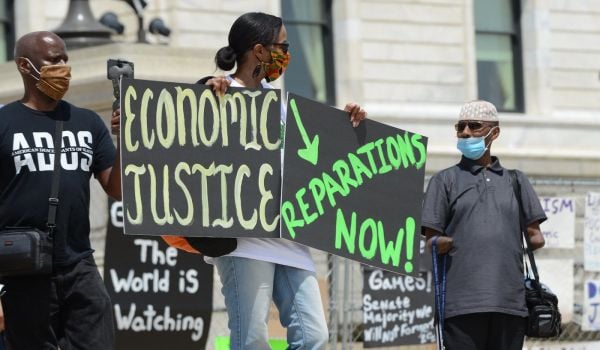A lot has changed in terms of the politics of housing since we sent the first issue of this newsletter in March. I expect a lot more will change next year, as progressive campaigns try to capitalize on the momentum they’ve built over the last few months and the 2020 presidential campaign sorts itself out. Below are the major stories we watched in 2019, and some thoughts about the year to come.
Housing is a National Issue Now
On November 20, Representative Ilhan Omar (D-MN) introduced the Homes for All Act, calling for the federal government to spend $1 trillion on building 12 million new, publicly owned homes. Considering the steadily diminishing role of the federal government in housing over the last several decades, it’s a wildly ambitious proposal — but it’s only one of many big housing proposals to be introduced on the national stage this year. A few weeks prior to Omar’s proposal, Rep. Alexandria Ocasio-Cortez and Sen. Bernie Sanders introduced The Green New Deal for Public Housing Act, proposing a $180 billion upgrade of the country’s public housing stock that would reduce carbon emissions and provide job opportunities for public housing residents. Democratic presidential candidates from Amy Klobuchar to Elizabeth Warren have introduced housing proposals of their own. The level of ambition varies — the National Low-Income Housing Coalition is tracking all of the plans on its Our Homes, Our Votes website — but the fact that nearly every candidate has proposed a housing plan is a testament to how much housing has been elevated as a political concern. And throughout the year, demands that were first made in local housing campaigns have filtered up to the national stage.
Rent Regulation Makes a Comeback
It was a banner year for proponents of rent control. For decades, as we wrote in the spring, rent control was considered largely a relic of a bygone era, written off by most economists as ineffective and counterproductive, leading to increased rents over time. Many economists still believe that. But this year, progressive housing advocates have pushed past those arguments. In the spring, the Right to the City Alliance, PolicyLink, and the Center for Popular Democracy co-published a report arguing that “it is time for policymakers to respond to the call for rent control to protect tenants from skyrocketing rents and displacement.” Implementing rent control nationwide would stabilize 42 million households, the groups wrote.
Cities and states pushed forward with variations on the rent-control theme. In February, Oregon became the first state with a rent stabilization policy, capping yearly rent increases at 7 percent plus inflation. New York state passed laws in June allowing more cities to adopt rent-control policies of their own and updating the rent-control rules in New York City. California capped yearly rent increases in September. Lawmakers in Massachusetts are considering a proposal to undo a 1994 ban on rent control, and there are signs that Washington may reconsider its ban as well. And far-fetched as it may be at the national level, the demand has national momentum, with national rent control included in ambitious housing plans introduced this fall by Congresswomen Ocasio-Cortez and Omar. Bernie Sanders, currently a frontrunner in the 2020 Democratic primary, put it in plain terms on Twitter in September: “We need national rent control.”
Cities Tackle Eviction Crises
In 2017, New York City became the first city to guarantee legal representation to certain tenants facing eviction. Research published earlier this year by the Community Service Society suggests that the program is working, with the rate of evictions falling faster in zip codes where the “right to counsel” was available versus those where it was not. Two years after New York broke ground, five cities have adopted some version of the right to counsel for tenants facing eviction, including San Francisco, Philadelphia, Cleveland, and Newark. Minneapolis has put some money toward legal defense for tenants as well, as Next City reported in August.
Cities experimented in other ways, too. The Syracuse Housing Authority saw a sharp drop in evictions after inaugurating a program that intervenes early when tenants are late on the rent. Kansas City adopted a Tenants Bill of Rights. Virginia’s governor recently announced funding for a statewide Eviction Prevention and Diversion Pilot Program (Next City coverage is on the way). And research continues to illuminate the eviction crisis, with data from the Eviction Lab at Princeton University and others fueling tenant campaigns around the United States.
California Is Still Having a Density Fight
California, the emblem of the growing national housing crisis with one of the worst shortages of affordable housing in the country, continued to struggle to find solutions in 2019. And the politics of the state’s battles over density and zoning remained complicated. In the spring, the state legislature considered a proposal from State Sen. Scott Wiener that would have required cities to permit dense housing projects near transit infrastructure and jobs in order to increase housing supply in hopes of making housing more affordable. The proposal reignited a debate from the previous year, around a similar bill. Beyond the standard fare of NIMBY opposition, some tenant groups opposed SB50, convinced that marginalized communities wouldn’t benefit directly from the law, and could even be put at greater risk of displacement. The proposal is likely to be revived again next year, but the political questions have yet to be resolved.
Nearly Everyone is Acknowledging Market Failures
“All these programs that are essentially designed to try to incentivize private capital to build affordable housing are not capable of getting the job done,” Joel Sipress, a city councilor in Duluth, Minnesota, told me in November.
It was a sentiment I heard throughout the year — that whatever the solution to the growing lack of affordable housing was, it wasn’t going to come entirely or even mostly from the private sector. The profit motive of developers only generates certain types of housing, and more and more people are skeptical that simply making things easier for developers will be good for people who need an affordable place to live, especially as rent increases continue to outpace wage growth. And as the shortage of affordable housing gets worse, and housing becomes an increasingly national conversation, local policies that were growing in popularity just a few years ago, like inclusionary zoning and preserving “naturally occurring affordable housing,” have begun to look weak. As the journalist and organizer Julian Brave NoiseCat noted on Twitter, direct and ambitious proposals like the Homes Guarantee show just how little cities and states have to work with in trying to resolve their housing problems. What happens in 2020 could have big consequences for how the country’s housing crisis evolves.
This article is part of Backyard, a newsletter exploring scalable solutions to make housing fairer, more affordable and more environmentally sustainable. Subscribe to our weekly Backyard newsletter.

Jared Brey is Next City's housing correspondent, based in Philadelphia. He is a former staff writer at Philadelphia magazine and PlanPhilly, and his work has appeared in Columbia Journalism Review, Landscape Architecture Magazine, U.S. News & World Report, Philadelphia Weekly, and other publications.
Follow Jared .(JavaScript must be enabled to view this email address)


















